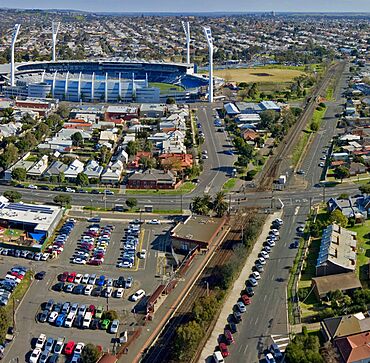South Geelong, Victoria facts for kids
Quick facts for kids South GeelongGeelong, Victoria |
|||||||||||||||
|---|---|---|---|---|---|---|---|---|---|---|---|---|---|---|---|

Aerial view of western part of South Geelong, including the railway station, AFL stadium and nearby residential areas
|
|||||||||||||||
| Population | 993 (2016 census) | ||||||||||||||
| Postcode(s) | 3220 | ||||||||||||||
| Location | 2 km (1 mi) from Geelong | ||||||||||||||
| LGA(s) | City of Greater Geelong | ||||||||||||||
| State electorate(s) | Geelong | ||||||||||||||
| Federal Division(s) | Corio | ||||||||||||||
|
|||||||||||||||
South Geelong, also known as Geelong South, is a suburb located south of Geelong, Victoria, Australia. It's part of the City of Greater Geelong, which is like its local council. In 2016, about 993 people lived in South Geelong.
This suburb is very close to Geelong's main city area. The Barwon River forms its southern edge. South Geelong is also the starting point for the Bellarine Rail Trail. This is a 32-kilometer path for walking and cycling that goes all the way to Queenscliff.
A big business in South Geelong is the Godfrey Hirst carpet factory. It's located on Barwon Terrace. The Post Office here first opened in 1921 as South Geelong. It was later renamed Geelong South in 1941.
Contents
Who Lives in South Geelong?
In 2011, there were 907 people living in 459 homes in South Geelong. Most people (about 79.8%) were born in Australia. Other common birthplaces included England (3.1%), India (1.5%), and China (1.2%).
About half the people (50.3%) in South Geelong are Christian. Around 30% said they didn't have a religion.
South Geelong's Past
South Geelong is one of the oldest suburbs in Geelong. It's even where the very first house in Geelong was built!
Back in 1836, a man named David Fisher set up a camp here. He built the first proper house in Geelong. It was made of timber and stood near the Barwon River. This house was so important that even the Governor, Sir Richard Bourke, visited it.
Interestingly, on the night Sir Richard Bourke arrived, there was an earthquake! An old local Aboriginal man, King Murradock, told David Fisher that earthquakes had happened before, but "long, long ago."
In 1837, David Fisher finished his house and brought his family over. They traveled on the James Watt, which was the first steamship to visit these shores.
Historic Places to See
South Geelong has many buildings and places that are important to its history. These are called heritage-listed sites. Some of them include:
- South Geelong Primary School
- Austin Hall & Austin Terraces (on Carr Street and Mundy Street)
- Rosebank, on Latrobe Terrace
- Several houses on Lonsdale Street (like numbers 4, 16, 22, 24, 26)
- 50 Mundy Street
- 247 Bellarine Street
- 46 Verner Street
- 487 Moorabool Street
- 256 – 259 Yarra Street
- 12 Verner Street
Fun Things to Do
South Geelong has old and new pubs, restaurants, and even Geelong's only independent movie theater.
The Barwon Club Hotel on Moorabool Street has been a hotel since 1856. It has had different names over the years.
The Pivitonian Cinema opened in 2016, offering a unique movie experience.
If you like puzzles and adventures, the official Escape Room Geelong opened in South Geelong in late 2015.
Sports and Outdoors
The John Landy Athletic Field is a special place for sports. It's located at Barwon Terrace and Swanston Street. This field was built in the early 1960s. It's named after John Landy, a famous Australian runner.
Landy Field is home to several athletics groups, including Geelong Athletics and the Geelong Little Athletics Centre. Little Athletics is a program that helps young kids get into sports.
South Geelong is also home to two of Australia's oldest rowing clubs:
- The Barwon Rowing Club, started in 1870.
- The Corio Bay Rowing Club, started in 1873.
As mentioned earlier, South Geelong is the start of the Bellarine Rail Trail. This 32-kilometer path is great for walking and cycling. It follows the old railway line that used to go from South Geelong to Queenscliff.
Images for kids









